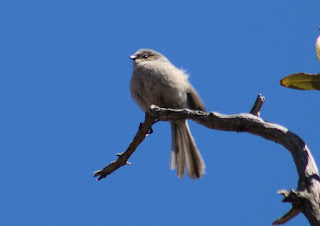Thunderbird Conservation Park 3.16.20
This spot is mostly known for its hiking trails. I've been birding here several times, but this time it was truly a special day. I got out the car and right at that very moment I hear the loud chattering calls of a Gilded Flicker. It was guaranteed a Gilded because the Northern Flickers aren't found in the desert, they are more commonly found in coniferous forests and parks. Ok keeping that aside, I let that go and proceeded on birding along the road. The previous time I went there I saw a Loggerhead Shrike which was my first time seeing one.. that's why birded along there in search for a second look at it. As I was walking I birded along a specific patch of saguaros where I've seen the flickers previously. And out popped a female... this very tame flicker allowed me to get sublime pictures that I'll allow the picture to speak for themselves. I already had shots of the male so I'm glad I got shots of the female as well. After I was done with the GILDED FLICKER I got myself back on the trail to continue my birding adventure. I birded along a wash were I saw four species in one dead tree, a male LADDER-BACKED WOODPECKER, CURVE-BILLED THRASHER, NORTHERN MOCKINGBIRD, and to top it off a CACTUS WREN. As I was taking pictures of the birds I saw a black flash zoom past my viewfinder screen. Taking my eyes off of the viewfinder I realize that was a PHAINOPEPLA. These are gorgeous birds that belong to the group of silky-flycatchers, the only species in North America. The only time I've previously seen this species was at the Salt River and Saguaro Lake were they were abundant. Now, I was back on the road, birding along the mountain. That's when I hear the rattling call of a Black-Tailed Gnatcatcher. Actually I was in search for the Blue-Gray Gnatcatcher but this species will do because the last time I saw the BLACK-TAILED GNATCATCHER was in my neighborhood wash in winter plumage. I played some calls and that little tiny bird sparked like a firecracker. Jumping on twigs feet away from me. Calling and calling as if I was a gnatcatcher competing. I took shots of it and on I went. Later on the trail I saw VERDIN, WHITE-CROWNED SPARROW, ANNA'S HUMMINGBIRD, and no shrike. I headed more and more until I heard squeaky chipping noises. When I first heard it I was sure it was the rusty gate's hinges at the entrance but as I was walking the noise got louder and louder. What was this noise, and where was it coming from!? I headed to the side of the road where it sounded like the noise was coming from. Nothing. Nothing was there. I walked a few more steps until I saw rustling in a bush. I got a look and there it was a Bewick's Wren. Wait....that distinctive eye line doesn't belong to a Bewick's Wren but to a BLACK-THROATED SPARROW! I coruched down on my news and pressed the shutter praying for some nice shots cause I mean this sparrow was like only a foot away from me. It then flew on to a bush with a goergeous backdrop of blooming yellow flowers(more gorgeous shots...) and then to a cholla cactus which literally gave me the best pictures I was waiting for. After taking at least 40 shots I headed back to the car. On the way I realized how funny things turned out... I was hoping for the shrike but I got something much better. Photos I will never forget from where I got them from and how I got them. I realized that I found the Black-Throated Sparrow right were I saw the shrike...
Gilded Flicker
Black-Tailed Gnatcatcher
Desert Cottontail
Anna's Hummingbird
Black-Throated Sparrow
Overall, this place is truly underbirded. There are many birds to expect when coming here. From all the desert species to possibly some owls waiting to be found in the washes. Also if you plan on coming here take extra precautions in bringing necessary materials such as water and proper attire. If you come stop by the viewing blinds which are near the park... these blinds provide awesome looks at wintering waterfowl such as common mergansers, ruddy duck, herons and egrets, ring-necked ducks, double-crested and neotropic cormorants, and even rarities such as cackling geese. This place might be underestimated but if you're in the area be sure to stop by. The map below shows an aerial view of the park and the viewing blinds which are highlighted in teal. The road that I birded on is highlighted in red and parking is in magenta. The hiking trails can also be birded but those are easily seen on the map. For now I've only birded along the mountain shown but soon I'd like to bird at the others as well. Hope this map helps :)
















Comments
Post a Comment